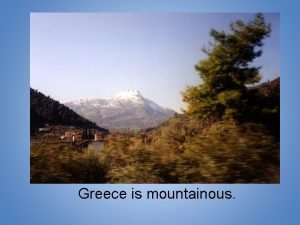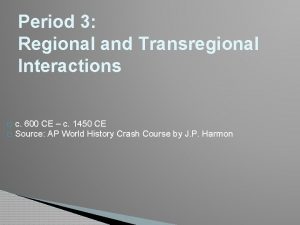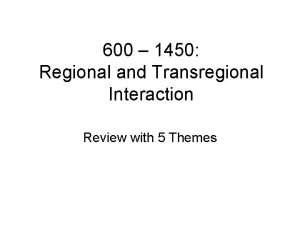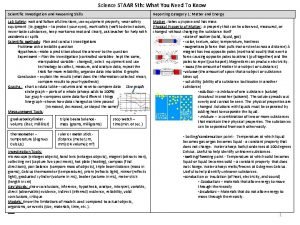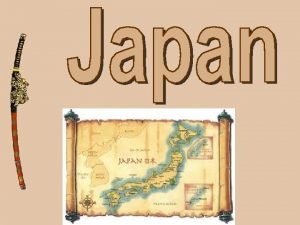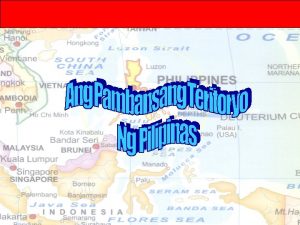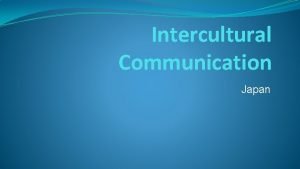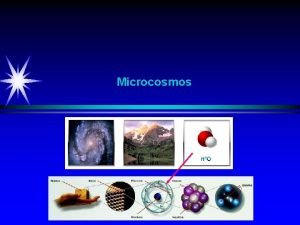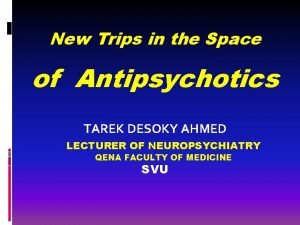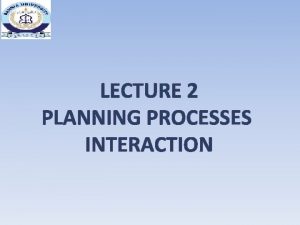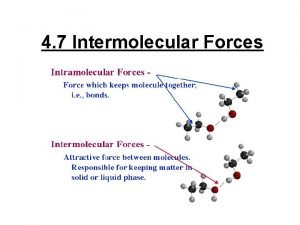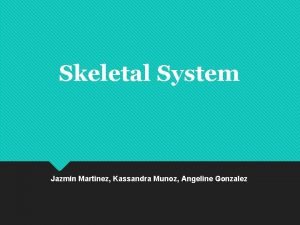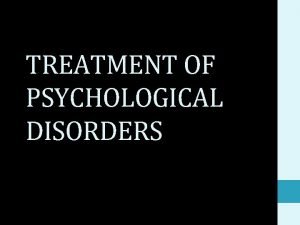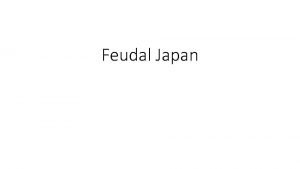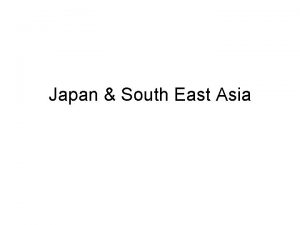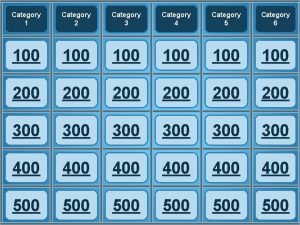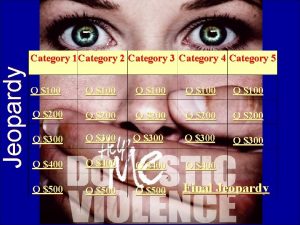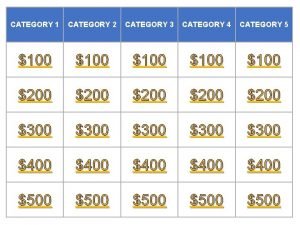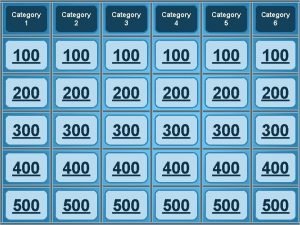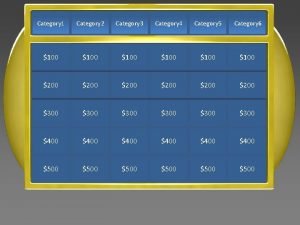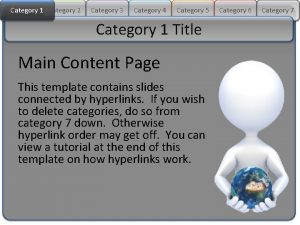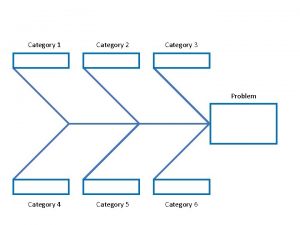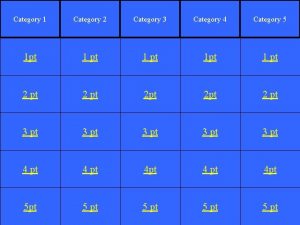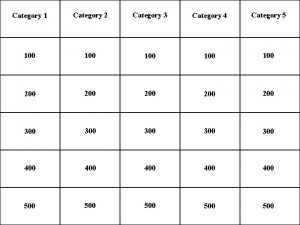Reporting Category 4 Regional Interactions Japan Mountainous Archipelago

























- Slides: 25

Reporting Category 4 Regional Interactions

Japan �Mountainous Archipelago (chain of islands) �Four Main Islands �Close to China and Korea �Sea of Japan or the East Sea is between Japan and the Asian Mainland

Chinese Influence on Japan �Writing �Architecture �Buddhism

Shinto �Ethnic religion unique to Japan �Importance of natural features, forces of nature, and ancestors �State religion; worship of the emperor �Coexistence with Buddhism

African Kingdoms �Axum (Aksum) �Eastern Africa �Location near the Red Sea and the Nile River �Located in modern day Ethiopia �Only early African Kingdom that practiced Christianity

West African Kingdoms �Ghana, Mali, and Songhai were all located near the Niger River and Sahara Desert �Traded Gold and Salt along the Trans-Saharan trade routes �Timbuktu was center of learning �Islamic


Zimbabwe �Located between the Limpopo and the Zambezi Rivers �City of “Great Zimbabwe” was the capital of a prosperous empire

Mayan Civilization �Mexican & Central American Rain Forests �Chichen Itza – Major City �City States ruled by Kings �Polytheistic: Pyramids �Economy: Agriculture & Tribute from conquered people

Aztec Civilization �Arid valley in central Mexico �Tenochtitlan – Major city �Ruled by an emperor �Polytheistic: Rituals, Pyramids �Economy: Agriculture, Tributes from conquered peoples

Meso-American Achievements �Calendars �Math �Writing and other record-keeping systems QUIPO

Rise of Nation States - England �William the Conqueror �Norman Conquest (French) �Battle of Hastings �Common Law started under Henry II �Magna Carta �Signed by King John �Limited King’s power �Hundred Years’ War �England vs. France �Defined England as a Nation �Evolution of Parliament

Rise of Nation States - France �Hugh Capet �Established French throne in Paris �Expanded control over most of France �Hundred Years’ War �Helped define France as a nation �Joan of Arc �Message from God �Defeated English at Orleans �Unifying factor for French

Rise of Nation States - Spain �Ferdinand & Isabella �“Reconquesta” �Unified Spain �Expelled the Moors and the Jews �Unified as a Catholic Nation �Charles V �Expanded the Spanish Empire in the Western Hemisphere

Rise of Nation States - Russia �Ivan the Great �Refused to pay tribute to the Mongols �Centralized power in Moscow �Expanded the nation �Power was centralized in the hands of the tsar �The Orthodox Church influenced unification

Key events of the Crusdades �Pope Urban’s Speech �Call to arms �Promised Salvation �Capture of Jerusalem �Founding of Crusader States �Loss of Jerusalem to Saladin �Sack of Constantinople by Western Crusaders

Effects of the Crusades �Weakened the power of the Pope & Nobles �Strengthened the Monarch �Stimulated trade w/ the Middle East � Demand for new goods � Trade through Middle East and Mediterranean Sea �Legacy of bitterness between Jews, Christians, and Muslims �Weakened Byzantine Empire

The Mongols �Invaded Russia, China, and Muslim states in Southwest �Destroyed cities and countrysides �Created an Empire

Constantinople �Fell to the Ottoman Turks in 1453 �This ended the Byzantine Empire �Became the capital of the Ottoman Empire �Changed the name to Istanbul

Impact of the Black Death (Bubonic Plague) �Population Decline �Reduction in Labor Force �Towns freed from Feudal Obligations �Decline in Church Influence �Disruption of Trade

Renaissance in Italy �Medieval Art & Literature focused on the Church & Salvation �Renaissance Art & Literature focused on individuals and secular (worldly) matters, along with Christianity �Wealth of independent Italian City States through trade �Increase in Banking and Credit

Art & Literature in Italy �Leonardo da Vinci Mona Lisa � The Last Supper � �Michaelangelo David � Ceiling of the Sisten Chapel � �Petrarch � Sonnets, humanist scholarship

Humanism �Celebrated the Individual �Stimulated the study of classical Greek and Roman Literature and Culture (Greco-Roman) �Supported by wealthy Patrons

The Northern Renaissance �Growing wealth in Northern Europe supported Renaissance ideas �Merged Humanist Ideals w/ Christianity �Moveable type printing press, productino and Sales of Books spread ideas and literacy �Johan Gutenberg �Gutenberg Bible

Northern Renaissance Writers �Erasmus � The Praise of Folly (1511) �Sir Thomas More � Utopia (1516) �Northern Renaissance artists portrayed both religious and secular (worldly) subjects
 Is greece a peninsula
Is greece a peninsula Erate category 2 eligible equipment
Erate category 2 eligible equipment Regional and transregional interactions
Regional and transregional interactions Regional and transregional interactions
Regional and transregional interactions Reporting category 3 earth and space
Reporting category 3 earth and space Archipelago definition geography
Archipelago definition geography Gulag archipelago
Gulag archipelago Ang pilipinas ay binubuo ng ilang kapuluan
Ang pilipinas ay binubuo ng ilang kapuluan Stratovolcanic archipelago
Stratovolcanic archipelago Pathway that food takes through the digestive system
Pathway that food takes through the digestive system Microcosmos macrocosmos
Microcosmos macrocosmos Diazepam cyp450
Diazepam cyp450 Sertraline interactions
Sertraline interactions Interaction planning process
Interaction planning process Photosynthesis is important to animals because flocabulary
Photosynthesis is important to animals because flocabulary Intramolecular forces
Intramolecular forces Contractionary monetary policy
Contractionary monetary policy Foss chemical interactions
Foss chemical interactions Ecosystems interactions
Ecosystems interactions Types of modular architecture
Types of modular architecture Circulatory system interactions with other systems
Circulatory system interactions with other systems Competition symbiotic relationship
Competition symbiotic relationship Interactions
Interactions Skeletal interactions with other systems
Skeletal interactions with other systems What is abiotic factor
What is abiotic factor Insight therapies involve verbal interactions
Insight therapies involve verbal interactions
